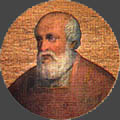 In sharp contrast
to the high-born blue blood Calixtus II, his successor Lambert was born of a
poor family. But in the Middle Ages the Church provided a career open to talent,
and of talent Lambert had plenty. About his early life little is known except
that he was born at Fiagnano near Imola. He must have had a good education for
he had the reputation of being crammed full of literature. He became archdeacon
of Bologna and then under Urban II joined the papal court.
In sharp contrast
to the high-born blue blood Calixtus II, his successor Lambert was born of a
poor family. But in the Middle Ages the Church provided a career open to talent,
and of talent Lambert had plenty. About his early life little is known except
that he was born at Fiagnano near Imola. He must have had a good education for
he had the reputation of being crammed full of literature. He became archdeacon
of Bologna and then under Urban II joined the papal court.
Paschal II made him cardinal-bishop of Ostia and Calixtus II sent him as legate
to the famous Diet of Worms. There his diplomatic skill helped to bring an end
to the lay investiture struggle. This success gave Lambert a reputation and made
him an outstanding possibility for the papacy. Yet his election was to be most
peculiar. With the strong hand of Calixtus removed, Rome rapidly returned to its
customary disorder. The powerful Frangipane family wished to secure the election
of Lambert, but the popular choice was Cardinal Saxo. The cardinals, as often
happens chose neither favorite, but a dark horse, Theobald Buccapecu, who was
called Celestine II. But while the cardinals, Lambert among them, were singing
the Te Deum, the irritated Frangipani began to shout, "Lambert Pope!" and
without more ado hustled Lambert off to a throne and proclaimed him Honorius II.
A nasty schism was in the making, but Theobald, a good humble man, seeing that
most of the cardinals went over to Honorius, resigned. Honorius also had qualms.
Calling the cardinals together he too resigned; but though the cardinals
accepted the resignation, they immediately re-elected him. His conscience
appeased, Honorius accepted. Although the lay investiture quarrel had been
settled at Worms, Honorius might have had trouble with Henry V. That wily
monarch was not proving to be overnice in his fulfillment of the Concordat. But
Henry died in 1125 and with him ended the Salian dynasty.
His successor, Lothair of Supplinburg, loyally carried out the Concordat.
Honorius, in turn, loyally backed Lothair against a rebellion raised by Henry's
nephew, Frederick of Hohenstaufen. When Roger of Sicily tried to take over South
Italy, Honorius used both spiritual and temporal arms to stop him. Roger defied
both, and Honorius gave in and allowed Roger to unite South Italy and Sicily.
Honorius had to intervene strongly to restore good order in the great
monasteries of Monte Cassino and Cluny. He also tried to settle the quarrel
between Latin bishops in Palestine. A positive achievement was the solemn
confirmation of the Premonstratensian Order in 1126. Honorius also approved the
order of Knights Templar. These fighting monks along with the Hospitallers were
a mighty bastion to the Kingdom of Jerusalem. In 1130 Honorius felt that he was
dying. Since Cardinal Pierleone openly planned to succeed him, Honorius withdrew
to a monastery on the Celian. Even there his deathbed was disturbed. A rumor of
his death brought Pierleoni swarming around the monastery, and they dispersed
only when the sick Pope showed himself at a window. Honorius died on February
14, 1130.
Excerpted from "Popes
Through the Ages" by Joseph Brusher, S.J.

